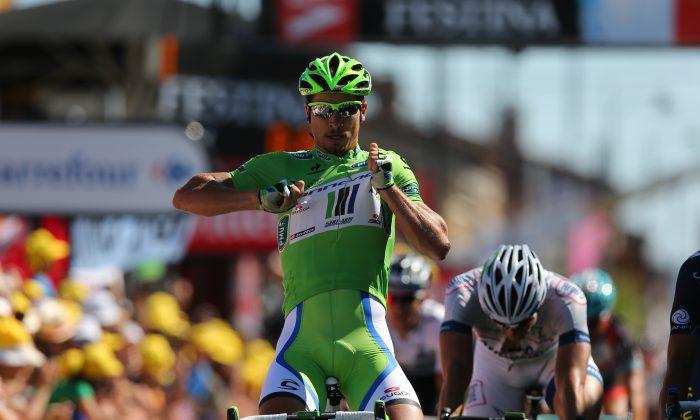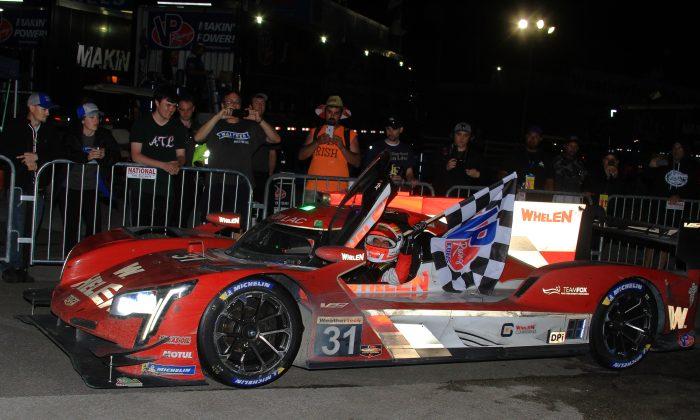Cannondale’s Peter Sagan took his first win of the 100th Tour de France with a strong sprint after a very hard drive by the entire Cannondale team cracked most of the pure sprinters.
Sagan, who had finished second three times (and third once) out of six stages, finally opened his account by outsprinting Argos-Shimano’s John Degenkolb after a hilly stage which saw the peloton split by the efforts of Sagan’s Cannondale team mates.
Take nothing away from Sagan: the 23-year-old super-rider made an amazing show of power in the sprint. But all credit goes to his Cannondale team mates, who outworked the combined efforts of three very powerful teams to split the peloton and shepherd Sagan to the line.
“I feel very good,” Sagan told Cyclingnews.com “I’m very happy and I have to thank my team because I couldn’t do what I did without my team. This victory is for all of the team.
“I’m very happy because I didn’t feel very good after the crash on the first stage but day by day I’m feeling better and now I’m really happy to have my first stage win of this Tour de France.”
Daryl Impey of Orica-GreenEdge retains the race leader’s yellow jersey.
Cannondale Domination
Stage Seven could have ended in a bunch sprint. Although the stage contained four categorized climbs, the only one that mattered was the Cat Two Col de la Croix de Mounis, 6.7 kms at 6.5 percent average grade, but with some ramps up to ten percent.
Col de la Croix de Mounis started 85 km into the stage; if the peloton cruised up it gently, all the big sprinters would have time to recover to contest the finish. Cannondale wasn’t going to allow that.
Omega Pharma-Quickstep was the first team to push the pace, chasing after RadioShack’s Jens Voigt and Ag2R’s Blel Kadri who attacked ten km into the stage. Once the gap hit six minutes, Omega came to the front, wanting a sprint finish and a second win for Mark Cavendish. Orica-GreenEdge also took some turns at the front, wanting to keep the yellow jersey.
Cannondale kicked into action on the lower slopes of the Col de la Croix de Mounis and raised the pace so high the three big sprinters—Omega’s Mark Cavendish, Lotto-Belisol’s André Greipel, and Argos Shimano’s Marcel Kittel—were dropped within a few kilometers.
Omega, Lotto, and Argos dropped back with their sprinters, planning to lead them back after the climb. Cannondale was determined not to let that happen. Amazingly, despite the best efforts of three powerful teams combining in the chase, Cannondale’s eight riders kept their advantage.
Kadri and Voigt were caught with 94 km left in the stage. Kadri was probably happy as he had won enough King of the Mountain points to take the lead in that competition. With two small climbs being the only obstacles left in the course, it seemed certain that the sprinters would catch the main peloton and battle it out at the finish. No team was willing to help Cannondale; everyone waited for the team to burn itself out.
When the team kept pushing the pace after the climb, it seemed that Cannondale was simply trying to keep the sprinters behind so Peter Sagan could win the intermediate sprint 70 km from the finish.
After Sagan won those 20 points, stretching his lead in the green Points jersey competition, Cannondale sat up for a few kilometers, letting Orica-GreenEdge take the lead. As soon as the pace slowed, RadioShack’s Jan Bakelants attacked, followed by Europcar’s Cyril Gautier and Juan José Oroz of Euskaltel-Euskadi.
Cannondale only rested for two kilometers; then the team moved back to the head of the peloton and once again lifted the pace. The second peloton, containing the sprinters, was 2:30 back with 66 km to go; that gap never got any smaller, despite the combined firepower of Lotto, Omega, and Argos.
Jan Bakelants become the virtual race leader with 54 km to go; Orica-GreenEdge realized this and sent a few riders to help the chasse with 50 km left. This ended any hope the sprinters’ teams might have had. With 42 km left in the stage, the Lotto, Argos, and Omega accepted their fates and sat up, deeming it wiser to save their legs for the next two mountain stages.
Cannondale still did the bulk of the work up front—their day’s efforts would be wasted if the breakaway survived. Orica helped a little, but mostly it was Cannondale setting a blistering pace for 110 kms, finally catching the three escapees three km from the line.
After all that effort, Cannondale was now faced with an even bigger task: finding the legs to lead out Peter Sagan against the riders still in the lead bunch. Argos-Shimano had the very capable John Degenkolb; Saxo-Tinkoff’s Daniel Bennati, Omega’s Michal Kwiatkowski, and most Sky’s Edvald Boasson Hagen were there, along with Astana’s Francesco Gavazzi and RadioShack’s Tony Gallopin.
These were all excellent sprinters; not quite in the Greipel/Cavendish class, but certainly among the top ten sprinters in the world. Cannondale, and Peter Sagan, had to beat these riders after pushing themselves for 110 kms.
Fifteen hundred meters from the finish, Cannondale still had three riders ahead of Sagan; at 1200 meters one dropped out, and Argos-Shimano came up with two riders ahead of Degenkolb. Lampre made the first move, leading out Manuele Mori; Degenkolb jumped onto Mori’s wheel.
Cannondale was almost boxed in, but squeezed through on the left. Degenkolb also pushed past on the left and opened his sprint. Sagan followed Degenkolb, and 150 meters from the finish pulled out and passed the Argos rider, winning the stage by eighteen inches.
And Now, the Mountains
Stages Eight and Nine open the alpine (or more properly Pyrenean) portion of the tour.
Stage Eight is pretty easy for the first 130 km; then it climbs the Hors Categorie Col de Pailhères, followed immediately by the Cat One climb to Ax Tres Domaines. With the top twenty-five riders in General Classification within 31 seconds of leader Daryl Impey, and more important, within 23 seconds of Sky’s Chris Froome, there is everything at play on these climbs. The yellow jersey will belong to whoever finishes first, and any rider who can’t keep the pace could lose the Tour here.
Stage Nine, coming before the first rest day, could be equally dramatic. No summit finish, but five categorized climbs a Cat 2 and four Cat 1s finishing with a fast 30-km descent should make for a lot of competition. A lot will depend on who wears the yellow jersey and by how much time.
Froome, Contador, Hesjedal, Danielson, Kreuziger, Van Garderen, Evans, Talansky, Pierre Rolland or Joaquim Rodriguez could make a move here, or a breakaway of riders further down in GC might get away—John Gadret, Alessandro De Marchi, or Thomas Voeckler.
With a rest day ahead, no one will need to conserve his legs; all-out attacks will be in order.
Sagan Opens His 2013 Tour de France Account With Stage Seven Win


7/5/2013
Updated: 7/5/2013




Friends Read Free